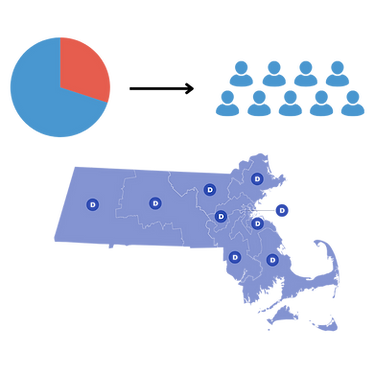WHAT IS PROPORTIONAL REPRESENTATION?
There are Two Systems Used to Elect Legislatures

The rules that govern our elections and determine how votes are translated into seats are called electoral systems. There are two types of electoral systems used by most of the world's democracies to elect their legislatures: winner-take-all systems, which tend to produce legislatures dominated by two major parties; and proportional representation, which produce multiparty legislatures. In the United States, we use a winner-take-all system.
Electoral Systems for National Legislatures
Proportional Representation (Partial or Full)
Winner-Take-All
Only countries categorized as full or flawed democracies according to the EIU are included. Electoral system classification provided by International IDEA.
Winner-take-all
The person with the most votes wins.
Winner-take-all electoral systems are those in which there is only a single candidate who wins all the representation. The most common is often known as 'first past the post' or 'plurality voting', where the winner is the candidate who receives the most votes, regardless of whether they won a majority. In the United States, this system is used to elect all members of Congress and the representatives of all 50 of our state legislatures. It’s also used in countries like Canada, India, the UK, and France.
The key feature of winner-take-all elections that limits representation is the single-member district. When only one representative serves an entire district, minority views are often excluded, and this often leads to legislatures dominated by two parties.
Share of Votes
Single-Member District
Legislative Representation

Example: Winner-Take-All System
Massachusetts’ 2022 Congressional Election

Share of Votes
Legislative Seats
Proportional Representation
A share of votes gets a share of seats.
Proportional representation refers to a type of electoral system that distributes legislative seats to political parties in proportion to the amount of votes they receive in elections. For example, if a party earns 30% of the vote in an election, they earn 30% of the seats in the legislature. This system is used to elect the legislatures of Germany, New Zealand, Taiwan, and Uruguay. Among many benefits, democracy scholars argue that adopting PR in the US would do a far better job channeling the diversity of voters' views.
The key feature of proportional representation that leads to diverse representation and multiparty legislatures is the multi-member district. When multiple representatives are able to serve a district, multiple parties are able to represent voters' diversity in the legislature.

Legislative Representation
Share of Votes
Multi-Member District
Example: Proportional Representation
What PR could look like in Massachusetts
Share of Votes
Legislative Seats

Massachusetts maps courtesy of Protect Democracy.

LEARN MORE
Vox Media: "Winner-take-all elections... are actually a practice that most advanced democracies left behind long ago — and they’re what keep us from having more political options.
Even if you’re not sold on the need for more parties in the US, though, scratch the surface of “only one person can win” a little and you start to see how it actually produces perverse results within the two-party system as well. It’s a big part of why the political parties have moved farther apart from each other, and it leaves about half of the country without any political representation at all. Watch the video to the right to see how."
Representing the Golden State: Our Vision
Our national two-party system is uniquely antiquated and results in an us-vs-them political climate that's wholly unreflective of the diversity and cooperative potential of Californians. Our state has no shortage of obstacles, from climate change to housing affordability and homelessness. We need a government capable of addressing complex problems through inclusive and dynamic policy-making. We need more parties. We need a system that rewards compromise and collaboration. We need proportional representation.
Key Takeaways
-
In California, the two-party dysfunction occurring on the national stage has manifested in one party dominating our state legislature for 60 of the last 65 years.
-
California’s lack of political representation means we can’t elect representatives from other parties with good ideas. That hurts the legislature’s ability to respond to the state’s needs.
-
Adopting proportional representation would lead to multiparty democracy in California, giving voters more meaningful electoral options and allowing them to better express where they stand on the political spectrum.
Imagining Proportional
Representation in California
Adopting proportional representation in California wouldn’t dramatically change our legislature overnight. But over time, our state’s political landscape would diversify considerably. The two-party system we have today would likely transform into a four or five party system. Below is a map of what the Assembly and its partisan makeup might look like after the adoption of multi-member districts and proportional representation.


Note: There are multiple types of proportional electoral systems and ProRep Coalition does not currently advocate for any particular form of PR. In addition, no one knows what new parties might form – or how they would fare electorally – after introducing proportional representation to the California Assembly. The map above is simply illustrative, using fictitious party names drawn from a New York Times editorial imagining a multiparty America.

